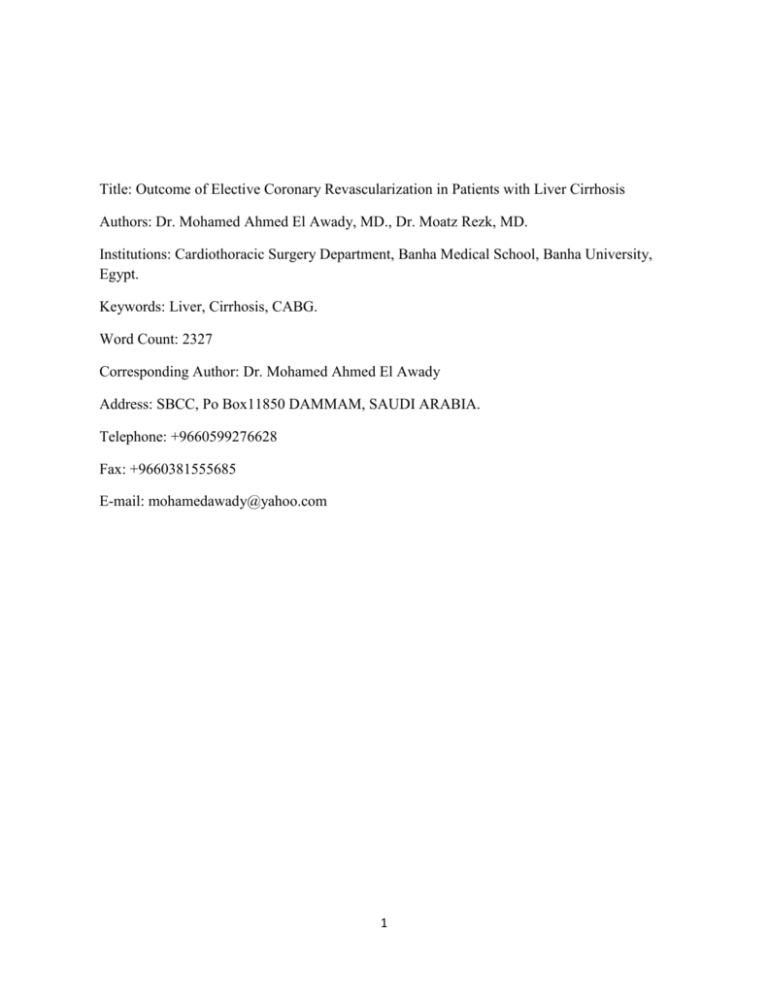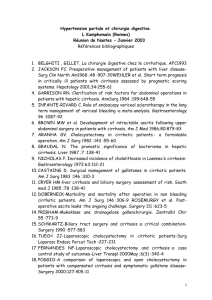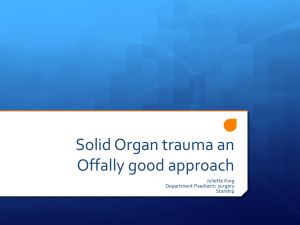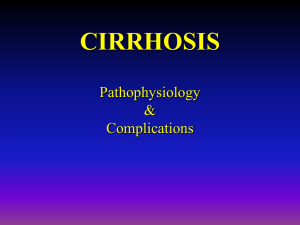Full paper
advertisement

Title: Outcome of Elective Coronary Revascularization in Patients with Liver Cirrhosis Authors: Dr. Mohamed Ahmed El Awady, MD., Dr. Moatz Rezk, MD. Institutions: Cardiothoracic Surgery Department, Banha Medical School, Banha University, Egypt. Keywords: Liver, Cirrhosis, CABG. Word Count: 2327 Corresponding Author: Dr. Mohamed Ahmed El Awady Address: SBCC, Po Box11850 DAMMAM, SAUDI ARABIA. Telephone: +9660599276628 Fax: +9660381555685 E-mail: mohamedawady@yahoo.com 1 Outcome of Elective Coronary Revascularization in Patients with Liver Cirrhosis Dr. Mohamed Ahmed El Awady, MD., Dr. Moatz Rezk, MD Objectives: Coronary artery bypass grafting in cirrhotic patients carries high risk of morbidity and mortality. Most of these complications are related to hepato-renal failure, bleeding and postoperative wound infection rather than cardiac problems. Methods: Prospective study to evaluate elective CABG early postoperative outcome of elective CABG in patients with Class A Child Pugh liver cirrhosis. Results From October 2007 to April 2011total 59 patients with Class A liver failure underwent elective CABG.37male, 22female.42hypertensives and 28diabetics.Mean1st 24hours chest tube drainage was 853.80±56.10ml, minimal 130ml maximum 3500 ml.12 patients (20.3%) were re-explored for bleeding. Mean ventilation time was 10.48± 6.65 hours. Mean ICU stay was 59.52± 13.91hours. Two patients (3.38%) died one patient due to hepato-renal failure (re explored 3 times) while the 2nd patient died after delayed recovery due to cerebral hemorrhage . 20 patients (33.89%) had wound infection ,two need debridement and rewiring . Mean hospital stay was 9.18±2.29days. Total morbidity was 49%. Total mortality was 3.38%. Conclusion: Elective CABG can be tolerated satisfactorily in class A Child Pugh cirrhotic patients with high incidence of the postoperative complications specially bleeding and wound infection. 2 INTRODUCTION Open heart surgery in cirrhotic patients had relatively high risk of morbidity and mortality when compared to non cirrhotic patients mainly Postoperative liver decomposition, bleeding and high incidence of postoperative wound infection (1-5) Child Pugh classification (6) (Table 1) consists of certain clinical, laboratory and radiological parameters to classify liver cirrhotic patients into A, B and C classes. Class A has the best condition while class C has the worst condition. Table 1: Child-Pugh Classification of Severity of Liver Disease (6). Parameter Points assigned 1 2 3 Ascites Absent Slight Moderate Bilirrubin, mg/dL </= 2 2-3 >3 Albumin, g/dL >3.5 2.8-3.5 <2.8 Seconds over control 1-3 4-6 >6 INR <1.8 1.8-2.3 >2.3 Encephalopathy None Grade 1-2 Grade 3-4 Prothrombin time INR: International Normalised Ratio. A total score of 5-6 is considered grade A (wellcompensated disease); 7-9 is grade B (significant functional compromise); and 10-15 is grade C (de-compensated disease). 3 Model for End-Stage Liver Disease (MELD) score (7) are calculated in cirrhotic patients to help in prediction of the excepted morbidity and mortality. MELD score ranging from 6 to 40, patients with score of 6 are the best ill patients while patients of 40 are the sickest one. The expected morbidity and mortality is much higher in patients with advanced Child Pugh Classification and high MELD score but there is no accurate predicator of outcome of open heart surgery in liver cirrhosis patients. Some studies used Child Pugh Classification others used Model for End-Stage Liver Disease (MELD) score to evaluate the outcome of CABG in liver cirrhosis patients but most of these studies of had limited number of patients (4, 5). The number of cirrhotic patients undergoing CABG is increasing in Egypt as it has one of the highest percentages of hepatitis C patients in the world ranging from 10% to 13% of the population (8), most of these patients are class A Child Pugh classification so we had this prospective study to evaluate the outcome of CABG in A class Child Pugh patients. All preoperative, operative and postoperative details are collected and analyzed. PATIENTS AND METHODS From April 2008 to April 2011 A prospective study to evaluate the outcome of elective CABG in class A cirrhotic patients. All patients had full clinical evaluation and full laboratory evaluation including complete blood picture, complete liver function and complete renal functions test. Enzyme-linked immunosorbent assay (ELISA) test was used in diagnose hepatitis markers. Abdominal ultra sound is done for all patients to evaluate the liver condition and diagnosis portal Hyperion. No liver biopsy was taken. Child Pugh classification and MELD score are calculated for all patients. Inclusion criteria: 1- Elective CABG. 2-Class A Child Pugh. 3-Good left ventricular function with ejection fraction above 35%. 4 Exclusion criteria are: 1- Class B and C Child Pugh classification. 2- Emergency or urgent CABG. 3- Redo CABG. 4- Open heart surgeries rather than CABG like valve surgery or combined surgery like CABG+ valve surgery. 5-Patients with poor left ventricular function with ejection fraction below 35% 6- Renal failure patients on regular dialysis. All preoperative, operative and postoperative data including 3 months follow up after discharge home are collected and analyzed. All patients continue on same drugs they usually use until the morning of the surgery except anti-platelets, which are stopped for 7 days before surgery. After the patients are anesthetizes, midline sternotomy is done. Pedicled left anterior mammary artery (LIMA) is harvested in all patients. All operations were performed utilizing conventional cardiopulmonary bypass (CPB) giving cold antigrade crystalloid cardioplegic solution repeated every 30 minutes. CPB was conducted using a membrane oxygenator and mild hypothermia (35C). Packed red blood cells were administered when haematocrit was less than 25%.fresh frozen plasma and platelets were administered when platelet count was less than 40000/ml or as a part of control postoperative bleeding. Postoperative complications were classified as follow: -Pulmonary: pneumonia, ventilator dependence greater than 48 hours, excessive pleural effusion requiring an additional drainage. 5 - Infectious (superficial and deep sternal wound infection). - Bleeding complications (re-exploration because of excessive mediastinal bleeding or cardiac tamponade requiring drainage). -Renal complications (increase in serum creatinine greater than 1.5mg/dl, oliguria (<0.5 ml/kg/min) for more than 6 hours postoperatively or any other indication for dialysis). -Other postoperative complications related to liver diseases, such as encephalopathy, hyperbilirubinemia and gastrointestinal bleeding as a result of varices were also recorded. Mortality is defined as death during a hospitalization for surgery, regardless of length of stay, or within 30 days from hospital discharge. Values of continuous variables were expressed as mean and standard deviation performed with computerized statistical packages (SPSS 18.0 software, SPSS, Chicago, IL, USA). RESULTS Total 59 patients were eligible for the study. Main cause of liver cirrhosis was hepatitis C (42 patients) and Hepatitis B (17patients) with no Alcoholic cirrhosis.47 male and 12 female .28 patients were diabetics while 42 were hypertensives. Mean MELD score was15.2±3.38 (minimal 8, maximum 23). Table 2 summarizes the preoperative patient’s profile. 6 Table (2): Preoperative Demographic and Laboratory Results. Variable Mean& Percent AGE 53.22± 8.23 MALE 37(62.71%) FEMALE 22 (37.28%) HYPERTENSIVE 12(16%) EF 52.76±6.79 DIABETICS 28(47.45%) MELD score 15.2±3.38(8-23) CREATININE 1.03 ± 0.18 UREA 18.13± 6.80 BILIRUBIN 0.90± 0.28 AST 34.02± 15.87 ALT 29.76± 13.83 ALBUMIN 3.96± 0.36 HB 12.78 ± 1.40 PLATLETS 168.40±55.65 EF: ejection fraction; HB: hemoglobin; ALT: Alanine Aminotransferase; AST: Aspartate Aminotransferase. 7 Mean number of grafts was 2.72 ±0.57. Mean cardiopulmonary bypass time was 62.27±6.40 minutes (minimum45, maximum78). Mean Cross-clamp time it was 41.53±5.85 (minimum 28 maximum 55min). No patients need intra aortic balloon pump. Table 3 summarizes the operative data. Table (3): Operative Data of the Patients. Variant Mean &ST GRAFTS 2.72±0.57(Min2,Max4 grafts) CPB(min) CXT(min) 53.28±20.31min 38.14±16.08min CPB: cardio-pulmonary bypass, CXT: cross clamp time, Min: minute. Min: minimum Max: maximum. 8 The postoperative mean chest tube drainage was 853.80±56.10ml; minimal 130ml maximum 3500 ml. Mean packed RBCS transfusion was 2.18±1.68 units. Mean fresh frozen plasma (FFP) Transfusion was 3.64±2.48 units. Mean platelets transfusion was 3.99±1.30 units. No postoperative myocardial infarction diagnosed by ECG and repeated cardiac enzyme. 12 patients were re-explored for bleeding (20.3%), 8 of them had cardiac tamponade. Mean ventilation time was 10.48± 6.6. Mean ICU stay was 59.52± 13.91hours.20 patients (33.89%) had wound infection,15 of them had leg wound infection,2 patients with mediastinitis needed debridement and rewiring. one patient had left sided clotted haemothorax diagnosed by CT chest drained though left mini thoracotomy. 21 patients(35.59%) had left pleural effusion ,all treated medically except 6 patents needed repeated pleural taping. Four patients readmitted due to mediastinitis, 2 of them had rewiring. Mean Hospital stay was 9.18±2.29days.Total morbidity was 49%. Total mortality was 3.38%. (2 patients),1st was re-explored 3 times for bleeding and died due to hepato-renal failure, 2nd patient had delayed recovery with right sided hemiplegia .CT brain showed cerebral hemorrhage. Table 4 summerizes the postoperative outcome. Table (4): Postoperative Outcome and Laboratory Results. 9 Variable VENTILATION TIME ICU TIME HOSPITAL STAY BLOOD LOSS RE-XPLORATION Tamponade PRBCS TRANSFUSION (unit) FFP(unit) PLALETS TRANSFUSION(unit) DEATH ALT AST TB UREA CREATININE Mean& SD 10.48± 6.65 59.52± 13.91 9.18±2.29 853.80±56.10 12(20.3%), 8(13.55%) 2.18±1.68 3.64±2.48 3.99±1.30 2(3.38%) 64.56± 45.01 42.38± 16.18 0.98± 0.52 18.90± 6.93 1.05± 0.43 SD: standard deviation; TB: total bilirubin; ALT: Alanine Aminotransferase; AST: Aspartate Aminotransferase; ICU: intensive care Unit; FFP: fresh frozen Plasma; PRBCS: packed red blood cells. Discussion Open heart surgery in cirrhotic patients carries high risk of postoperative morbidity and mortality. (1-5). There is Limited experience in open heart surgery in class A cirrhotic patients and most of these studies are of limited number (3,10-12) , emergency cases are included(13)or wide variety of surgical procedure are included(6).The total morbidity of open heart surgery in class A cirrhotic patients ranging from 39% to 60 % (13 -17). Most of these complications are not related to cardiac complications and mostly related to hepato-renal failure, bleeding and high incidence of postoperative infection (1-5, 8, 9). There is no accurate 10 predicator of outcome of CABG surgery in those patients as some studies used Child Pugh classification while others used MELD score as prognostic values for open heart surgery in cirrhotic patients (18, 19). Bleeding is major clinical problem of CABG in patients with liver disease as there are major alterations in the haemostatic pathways in most patients with liver disease including altered platelet and endothelial function, altered clotting factors and conditions such as hyperfibrinolysis, dysfibrinogenemia and renal failure which may be superimposed on these underlying abnormalities (20). Also Cardiopulmonary Bypass machine aggravates the coagulopathy inducing platelet dysfunction, fibrinolysis, and hypocalcemia (21). The postoperative high incidence of delayed wound healing and high infection rate is expected in this group of patients due to hypoalbumenia and relatively high incidence of blood products transfusion. (20). In our study the total morbidly percent was 49% most of these complications are related mainly to bleeding, infection, liver de-compensation and renal impairment rather than low cardiac output. In our study elective CABG in class A cirrhosis while other studies with relatively high morbidity emergency cases are included and other cardiac operations rather than CABG (3, 12-15). The mortality of open heart surgery in liver cirrhotic class A patients differs from study to other ranging from 5.2 % (2) to 15% (13).mostly related to sepsis and hepato-renal failure. In our study as emergency cases and other procedure rather than elective CABG are exclude, the postoperative mortality in was 3.38% mainly due to hepto-renal failure and cerebral hemorrhage. Table (4) summarizes the postoperative outcome and laboratory results. Conclusion: Elective Coronary artery bypass surgery in patients with class A Child Pugh cirrhosis can be tolerated satisfactorily with higher incidence of the postoperative complications specially bleeding and infection problems. 11 Reference 1- Akira Marui, Takeshi Kimura, Shiro Tanaka et al: Coronary Revascularization in Patients with Liver Cirrhosis: Ann Thorac Surg 2011; 91:1393-1399. 2- Amit Modi, Hunaid A. Vohra and Clifford W. Barlow: Do patients with liver cirrhosis undergoing cardiac surgery have acceptable outcomes? .Interact CardioVasc Thorac Surg 2010; 11:630-634. 3 - Akimasa Morisaki, Mitsuharu Hosono,Yasuyuki Sasaki et al. :Risk factor analysis in patients with liver cirrhosis undergoing cardiovascular operations. Ann Thorac Surg 2010; 89:811–817. 4- Nobuhiko Hayashida, Takahiro Shoujima, Hideki Teshima et al: Clinical outcome after cardiac operations in patients with Cirrhosis: The Annals of thoracic surgery. 2004; 77(2):500-505. 5- Yong An, Ying Bin Xiao and Qian-Jin Zhong: Open-heart surgery in patients with liver cirrhosis: Eur J Cardiothorac Surg 2007; 31:1094-1098. 6- Lucey MR, Brown KA, Everson GT et al.: Minimal criteria for placement of adults on the liver transplant waiting list: a report of a national conference organized by the American Society of Transplant Physicians and the American Association for the Study of Liver Diseases. Liver Transpl Surg 1997. Nov; 3(6):628-37. 7- Wiesner R, Edwards E, Freeman R et al: Model for end-stage liver disease (MELD) and allocation of donor livers. Gastroenterology (2003) vol. 124 (1) pp. 91. 8- Mohamed MK.: Epidemiology of HCV in Egypt 2004: The Afro-Arab Liver Journal, 2004; 3(2): 41-52. 9- John D. Klemperer, Wilson Ko, Karl H. Krieger et al.: Cardiac operations in patients with cirrhosis Ann Thorac Surg 1998; 65:85-87. 12 10- Philippe Bizouarn, Antoine Ausseur, Pascal Desseigne et al.: Early and late outcome after elective cardiac surgery in patients with cirrhosis. Ann Thorac Surg 1999; 67:1334- 1338. 11-Takashi Murashita, Tatsuhiko Komiya, Nobushige Tamura et al: Preoperative evaluation of patients with liver cirrhosis undergoing open heart surgery. Gen Thorac Cardiovasc Surg. 2009 Jun; 57(6):293-7. 12- Farzan Filsoufi, Salzberg SP, Rahmanian PB et al.: Early and late outcome of cardiac surgery in patients with liver cirrhosis. Liver Transpl 2007 Jul; 13(7):990-5. 13-Matthias Thielmann, Achmet Mechmet, Markus Neuhauser et al: Risk prediction and outcomes in patients with liver cirrhosis undergoing open-heart surgery. Eur J Cardiothorac Surg 2010; 38:592-599. 14- Cheng-Hsin Lin , Fang-Yue Lin , Shoei-Shen Wang et al : cardiac surgery in patients with liver cirrhosis .The Annals of Thoracic Surgery:2005; 79, 5, 1551-1554. 15- Mohsen Hammad, Asem Elfert, Hasan Elbateaet al: Clinical outcome after cardiac operations using cardiopulmonary bypass in patients with liver dysfunction. Arab J Gastroenterol 2006; 7(3): 98-101. 16-Yukiharu Sugimura, Masaaki Toyama, Masanori Katoh et al: Analysis of open heart surgery in patients with liver cirrhosis. Asian Cardiovasc Thorac 2012; 20:263-268. 17-Akira Marui, Takeshi Kimura, Shiro Tanaka et al: Coronary Revascularization in Patients with Liver Cirrhosis. Ann Thorac Surg 2011; 91:1393-1399 18-Suman A, Barnes DS, Zein NN et al. Predicting outcome after cardiac surgery in patients with cirrhosis a comparison of Child-Pugh and MELD scores. Clin Gastroenterol Hepatol 2004; 2:719-723 19- Gorav Ailawadi, Damien J. LaPar, Brian R. Swenson et al: Model for end-stage liver disease predicts mortality for tricuspid valve surgery. Ann Thorac Surg 2009; 87:1460-1468 13 20- Tripodi A, Salerno F, Chantarangkul V et al.: Evidence of normal thrombin generation in cirrhosis despite abnormal conventional coagulation tests. Hepatology 2005; 41:553–8. 21- Pollard RJ, Sidi A, Gibby GL. Et al: Aortic stenosis with end-stage liver disease: prioritizing surgical and anesthetic therapies.J Clin Anesth 1998; 10: 253-261. 14 15







